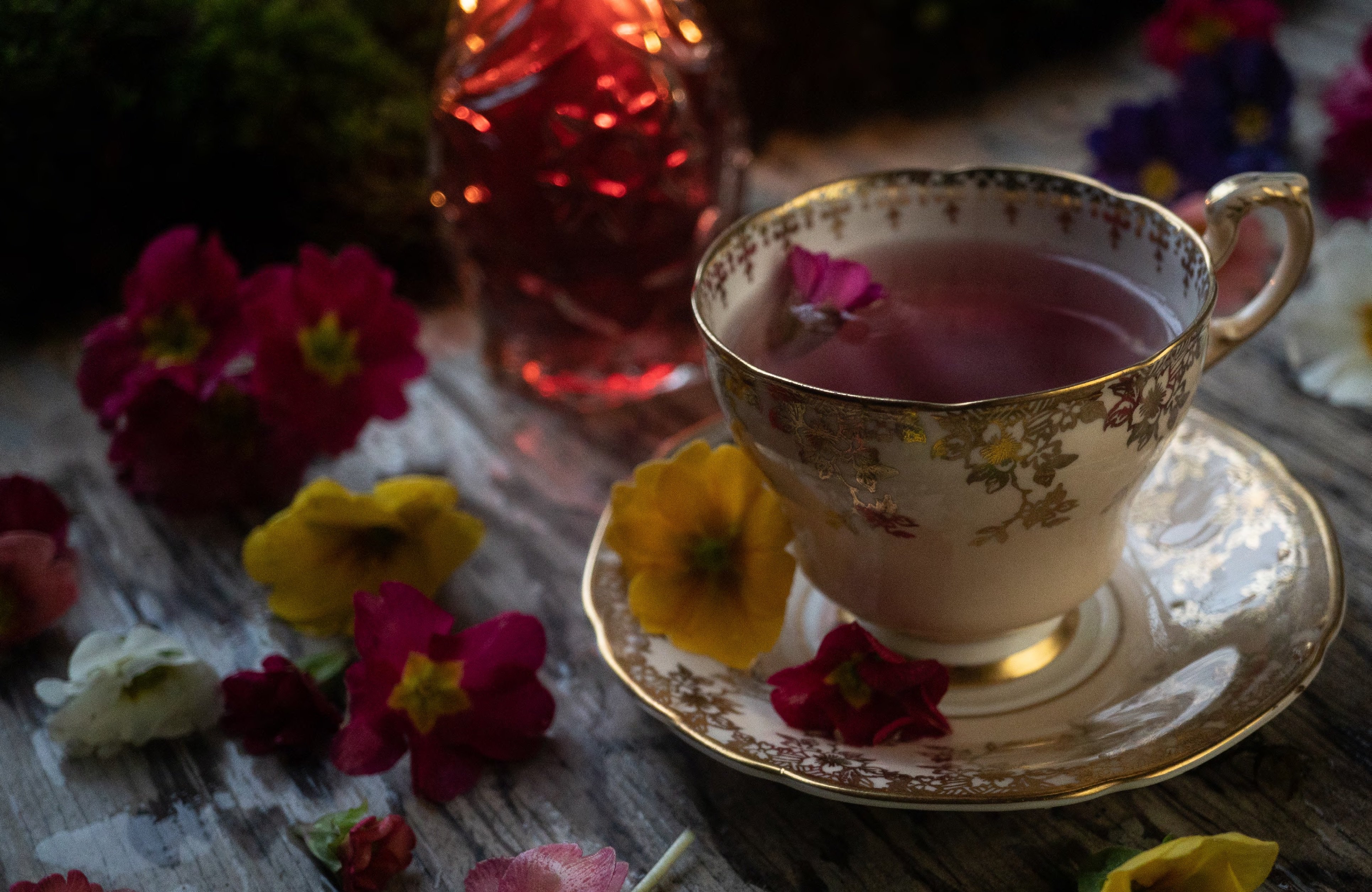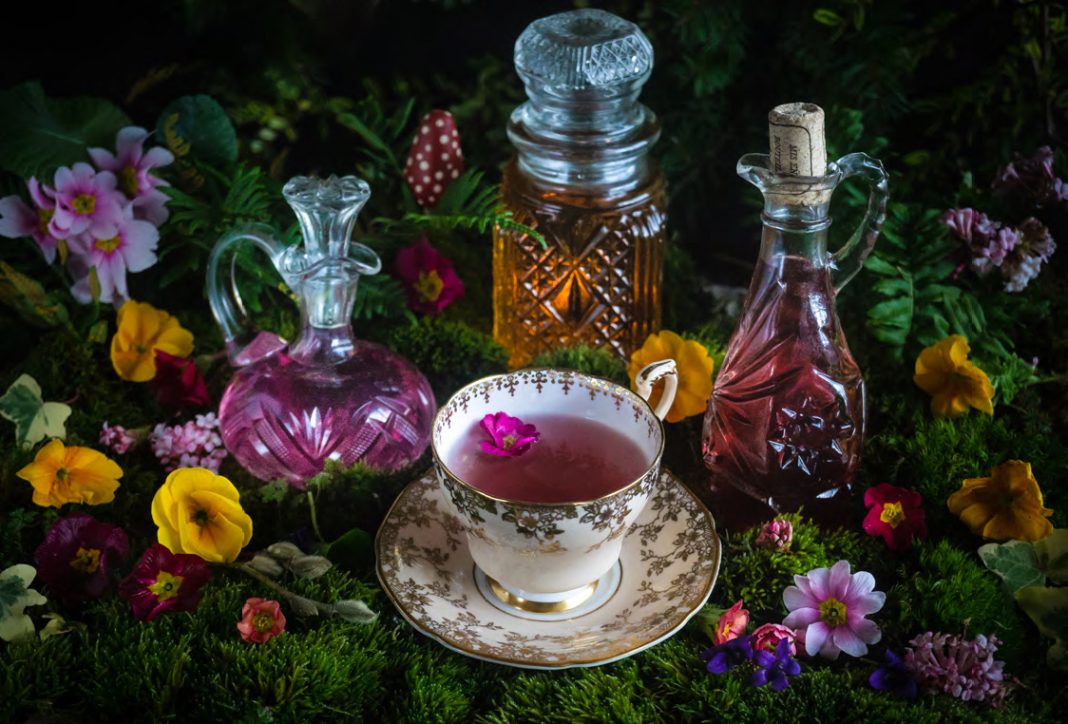When it comes to casting springtime spells of allure and amour, this delicately flavored and jewel-colored primrose cordial is easy to make and versatile to use. But whether sipped straight up or added to cocktails or a cup of warm fragrant tea, be warned: Primrose packs a libidinous punch. This “first rose” is not only renowned for her magical potency in love and beauty spells but reputed to bring on “wantonness”—hence Shakespeare’s famous phrase the “primrose path of dalliance”!
In early spring, as the seductive and procreative power of mother nature prepares to burst forth in a cascade of swelling blossoms, it is the bright palette of pinks, reds, blues, and purples of primrose that first brighten wintry garden beds, flower pots, and balcony boxes. But in forests across Europe, the original chaste white and yellow woodland primrose still grows wild. Nestling under trees or in shady pastures, large patches are said to be portals into the fairy realms, and in Irish legend, primroses bloomed in Tír na nÓg, the Land of Eternal Youth. Morning dew gathered from their blossoms was considered a beauty potion par excellence.
Her botanical name is Primula vulgaris (from the family Primulaceae), and her slightly sweet blossoms were prized in wine, spirits, cordials, jams, tarts, curds, and confections and as a “curing herb” for all manner of ills, rheumatics, gout, headaches, sleeplessness, chest problems, and “nervous hysterical disorders.” In modern herbal medicine, Primrose vulgaris is considered sedative and antispasmodic, and infusions of flowers are still used to soothe migraine headaches, insomnia, anxiety, PMS, rheumatism, and skin conditions. (Note: Pregnant women or people taking anticoagulant medicine are advised against consuming primrose.)
Whether the vivid colors of modern cultivated varieties retain the same medicinal potency as their wild counterparts isn’t clear. But several studies suggest they contain many of the same anti-inflammatory and immune-system-boosting phytonutrients and antioxidants found in brightly colored fruits and vegetables. Which is good!
All varieties of Primrose vulgaris are edible biennials that reseed themselves and often remain growing in the garden for several seasons. I recommend consuming these instead of newly purchased flowers from big-box stores or supermarkets, as it’s likely they still contain pesticide residues. But be careful that you’re not dealing with Primrose obconica, as it can cause skin rashes.
Capturing the flavor and colors of primrose in a cordial is simply a matter of picking the blossoms and infusing them in syrups and spirit. You can skip the spirits, but as alcohol acts as a preservative, your non-alcoholic cordial won’t have a long shelf life (two to three weeks). Cordials were originally created by 13th century alchemists by infusing herbs, blossoms, roots, and bark in alcohol. These life-giving elixirs were prescribed not just to cure disease but to revitalize the heart, body, and spirit. Gradually they began to be sweetened, evolving into 18th liqueurs consumed more for pleasure than health.
Today floral cordials may have fallen out of fashion, but they’re one of my favorite ways for capturing the scent, color, medicine, beauty, and mystery of flowers. And what better way to indulge in a little old-world romance than this primrose cordial? I promise, just a couple of sparkling tablespoons stirred into a warm cup of tea will turn your next quiet moment into an enchanted occasion!

PRIMROSE CORDIAL RECIPE
Ingredients
3 cups of primrose blossoms,
lightly rinsed and roughly chopped
2 cups of sugar
1 cup of water
½ cup of your spirit of choice
(vodka, rum, brandy, gin)
Directions Primrose Infused Spirits:
Place half of your chopped primrose blossoms in a mason jar with your alcohol of choice. Press down with a fork until blossoms are fully submerged. Seal and let sit in a dark place for at least a week; two to three weeks is best. Once ready, strain blossoms and put aside.
Primrose Syrup:
Take sugar and water and combine in a saucepan. Gently raise to boil and stir until sugar is completely dissolved. After five minutes, remove syrup from heat. Add the other half of your blossoms, stir, cover, and let sit overnight. The next day, strain the spent blossoms from your syrup. Mix this syrup with your primrose-infused spirits in a clean sterilized jar or pretty bottle. Cap and shake well. Your Primrose Cordial is ready to serve.


































